Write Tension That Isn't Just Yelling Or Guns
Write Tension that isn't just Yelling or Guns
Listen, not all tension is someone holding a knife or screaming “I’ve had enough, Derek!” at a dinner party. Real, edge-of-your-seat tension can be quiet, slow, awkward, and still make your reader grip the page like it owes them money. So here are my favorite ways to sneak tension in like a gremlin under the bed...
╰ Unanswered Questions (That the Character is Actively Avoiding)
Tension isn’t always about what’s said—it’s about what’s not said. Let your character dodge questions, interrupt, change subjects. Let readers feel the silence humming between the lines. + Great for: secrets, internal conflict, emotional gut-punches.
╰ Time Pressure Without Action Pressure
A clock ticking doesn’t always mean bombs. Sometimes it means waiting for a test result. A letter. A phone call. A knock on the door. Tension = knowing something’s coming but not knowing when. + Great for: psychological suspense, horror, relationship drama.
╰ Small Talk That’s Not Really Small Talk
When two characters are talking about the weather, but both are secretly screaming inside? That’s tension. Give one character a goal (say the thing, don’t say the thing) and the other a defense mechanism. Now sit back and watch the discomfort bloom. + Great for: slow burns, rivalries, “we’re not talking about that night, are we?”
╰ Two Characters Who Want Opposite Things But Are Pretending They Don’t
Someone wants to leave. Someone wants them to stay. Someone wants to confess. Someone is acting like nothing’s wrong. Make your characters polite when they want to scream. + Great for: emotionally repressed chaos, family drama, enemies-to-lovers.
╰ One Character Realizes Something The Other Doesn’t
A power shift = instant tension. One person knows the truth. The other’s still talking like everything’s fine. Let that dread slow-cook. Readers love being in on the secret. + Great for: betrayal, secrets, foreshadowing plot twists.
╰ Body Language That Contradicts the Dialogue
They say “I’m fine,” but they’re picking their thumbnail raw. They laugh too hard. Their smile doesn’t reach their eyes. Show the cracks forming. Let the reader sense the dissonance. + Great for: all genres. Especially emotionally loaded scenes.
╰ Echoed Phrases or Reused Words That Hit Differently the Second Time
When a character repeats something someone else said—but now it’s laced with bitterness or grief? Chills. Callback dialogue is your best friend for building subtle dread or emotional weight. + Great for: heartbreak scenes, arcs coming full circle, psychological unraveling.
╰ Characters Performing a Role to Keep the Peace
Pretending to be “the good sibling.” Faking confidence in a boardroom. Playing therapist when they’re not okay themselves. Tension thrives when someone’s holding it together with duct tape and fake smiles. + Great for: internal conflict, layered characterization, slow unravelings.
More Posts from Kunartis and Others

if you, like me, constantly get caught by surprise by time, and want a chill prompt list without feeling that you're already late and need to catch up, I made one
Pick a schedule (weekly, every other day, daily) and use the prompts on that row, or just be “Today I want to doodle” and pick any combination of adjacent prompts
i genuinely appreciate the effort, but that "non eyestrain" version of the cringetober prompt list is not in fact non eyestrain. try solid black text on a white background?

Sorry about that! Personally I find high contrast images even harder to look at, so I didn't consider the incredibly basic black text, white bg at first. I hope this works!!


Made a new version of my ship meme template, now with a three character version!!
Primarily made for selfshipping and OC x canon but could be used for any ship! I'd love to be tagged if you use this, but it's not a requirement.
Example under the cut!

My animation process (in a GIF!)

So you've learned the 12 principles of animation but don't know where to actually apply them? Fear not!! For here is my step-by-step process, very very condensed, into one singular giant GIF.
Hope it helps!
(You may need to open it in a new tab to read the text)
How fucking annoying is it when you feel so restless with creative energy but you can’t decide what to do with it and when you finally try to create something it comes out shit so you just give up and sit there being all creatively annoyed and jittery.
A general cane guide for writers and artists (from a cane user, writer, and artist!)
Disclaimer: Though I have been using a cane for 6 years, I am not a doctor, nor am I by any means an expert. This guide is true to my experience, but there are as many ways to use a cane as there are cane users!
This guide will not include: White canes for blindness, crutches, walkers, or wheelchairs as I have no personal experience with these.
This is meant to be a general guide to get you started and avoid some common mishaps/misconceptions in your writing, but you absolutely should continue to do your own research outside of this guide!
This is NOT a medical resource!!! And never tell a real person you think they're using a cane wrong!
![[Image text] Arm bends a little. Cane height at hip joint. Many canes have adjustable height. Cane sits within the natural center of balance. Causes stress on: Triceps, upper back, wrist (pressure) fingers (grip). Helps with: Joints (lower back, hip, knee, ankle, foot), weakness, balance, pain.](https://64.media.tumblr.com/0c8731401f496885dc8d4309a7dbe7ee/f831b3159e1d7635-e7/s500x750/6e5fe00081a6ce3b64cbe1a648f0c967f9f601e9.jpg)
The biggest recurring problem I've seen is using the cane on the wrong side. The cane goes on the opposite side of the pain! If your character has even-sided pain or needs it for balance/weakness, then use the cane in the non-dominant hand to keep the dominant hand free. Some cane users also switch sides to give their arm a rest!
A cane takes about 20% of your weight off the opposite leg. It should fit within your natural gait and become something of an extension of your body. If you need more weight off than 20%, then crutches, a walker, or a wheelchair is needed.
Putting more pressure on the cane, using it on the wrong side, or having it at the wrong height can make it less effective, and can cause long term damage to your body from improper pressure and posture. (Hugh Laurie genuinely hurt his body from years of using a cane wrong on House!)
(some people elect to use a cane wrong for their personal situation despite this, everyone is different!)

(an animated GIF of a cane matching the natural walking gait. It turns red when pressure is placed on it.)
When going up and down stairs, there is an ideal standard: You want to use the handrail and the cane at the same time, or prioritize the handrail if it's only on one side. When going up stairs you lead with your good leg and follow with the cane and hurt leg together. When going down stairs you lead with the cane and the bad leg and follow with the good leg!
Realistically though, many people don't move out of the way for cane users to access the railing, many stairs don't have railings, and many are wet, rusty, or generally not ideal to grip.
In these cases, if you have a friend nearby, holding on to them is a good idea. Or, take it one step at a time carefully if you're alone.
Now we come to a very common mistake I see... Using fashion canes for medical use!
![[Image text] 4 Major Handle Shapes (significant variation and uses). Tourist/Crook/Hook. Classic shape, fashion and medical, easy to hook on things (arm, door, chair, etc), generally solid wood (stronger, heavier). Offset. Newer design, not a fashion handle, only handle for quad-bases, generally better balance, usually aluminum (light + cheap), soft handle, adjustable (rattles/clicks when swinging). Derby/Fritz/Anatomical/Contour. Classic medical shape, many fashion variants, some fashion + medical, varies in many ways, sometimes contoured to hand, comes in foldable styles, many aluminum styles, many customizable styles. Knob/Decorative. Fashion exclusive, knob shape hurts the hand after prolonged pressure (especially with designs), tend to be heavy, "sword canes" have the same issues.](https://64.media.tumblr.com/102d2e5f13a88817eaa44974bc5a7486/f831b3159e1d7635-e2/s500x750/887023dbcfc758db12a7fcf3f258bca52eba2d53.jpg)
(These are 4 broad shapes, but there is INCREDIBLE variation in cane handles. Research heavily what will be best for your character's specific needs!)
The handle is the contact point for all the weight you're putting on your cane, and that pressure is being put onto your hand, wrist, and shoulder. So the shape is very important for long term use!
Knob handles (and very decorative handles) are not used for medical use for this reason. It adds extra stress to the body and can damage your hand to put constant pressure onto these painful shapes.
The weight of a cane is also incredibly important, as a heavier cane will cause wear on your body much faster. When you're using it all day, it gets heavy fast! If your character struggles with weakness, then they won't want a heavy cane if they can help it!
This is also part of why sword canes aren't usually very viable for medical use (along with them usually being knob handles) is that swords are extra weight!
However, a small knife or perhaps a retractable blade hidden within the base might be viable even for weak characters.
![[Image text] 4 Major base shapes (significant variation and uses). Adjustable base. Aluminum, standard modern medical, adjustable height, rubber base, wears down over time. Tripod/ quad base. If you need extra balance. Terrain attachment (varies, this is for ice). Removable, helps stop slipping on ice/snow/sand/etc, some canes have a retractable tip for ice. Classic base. Non-adjustable, custom only, modern standard still has a rubber base.](https://64.media.tumblr.com/78d350cfac4077376b7ce521a9a7d929/f831b3159e1d7635-ab/s500x750/4b4a6b8062c06686baf17c83c28b793bfb89e05b.jpg)
Bases have a lot of variability as well, and the modern standard is generally adjustable bases. Adjustable canes are very handy if your character regularly changes shoe height, for instance (gotta keep the height at your hip!)
Canes help on most terrain with their standard base and structure. But for some terrain, you might want a different base, or to forego the cane entirely! This article covers it pretty well.
Many cane users decorate their canes! Stickers are incredibly common, and painting canes is relatively common as well! You'll also see people replacing the standard wrist strap with a personalized one, or even adding a small charm to the ring the strap connects to. (nothing too large, or it gets annoying as the cane is swinging around everywhere)

(my canes, for reference)
If your character uses a cane full time, then they might also have multiple canes that look different aesthetically to match their outfits!
When it comes to practical things outside of the cane, you reasonably only have one hand available while it's being used. Many people will hook their cane onto their arm or let it dangle on the strap (if they have one) while using their cane arm, but it's often significantly less convenient than 2 hands. But, if you need 2 hands, then it's either setting the cane down or letting it hang!
For this reason, optimizing one handed use is ideal! Keeping bags/items on the side of your free hand helps keep your items accessible.
![[Image text] Where to put your stuff. Purses/bags. A lot of size range, Can mess with balance, Zippers are too hard with one hand, Handheld means you have no hands, over the shoulder only. Fanny pack. Accessible with one hand, Limited space, Good for balance. Backpack. Very physically comfortable, evenly weighted, holds a lot (medicine, foldable cane, emergency supplies, etc) can't access without fully stopping and putting cane down/hooking it on arm/dangling on strap. Pockets. Can only use on free side, many outfits don't have good pockets.](https://64.media.tumblr.com/de0f85e864c0ac470fb08900d78d8375/f831b3159e1d7635-21/s500x750/dbc646d95d144bb9c097f220361f074cc4b59584.jpg)
When sitting, the cane either leans against a wall or table, goes under the chair, or hooks onto the back of the chair. (It often falls when hanging off of a chair, in my experience)
When getting up, the user will either use their cane to help them balance/support as they stand, or get up and then grab their cane. This depends on what it's being used for (balance vs pain when walking, for instance!)
That's everything I can think of for now. Thank you for reading my long-but-absolutely-not-comprehensive list of things to keep in mind when writing or drawing a cane user!
Happy disability pride month! Go forth and make more characters use canes!!!

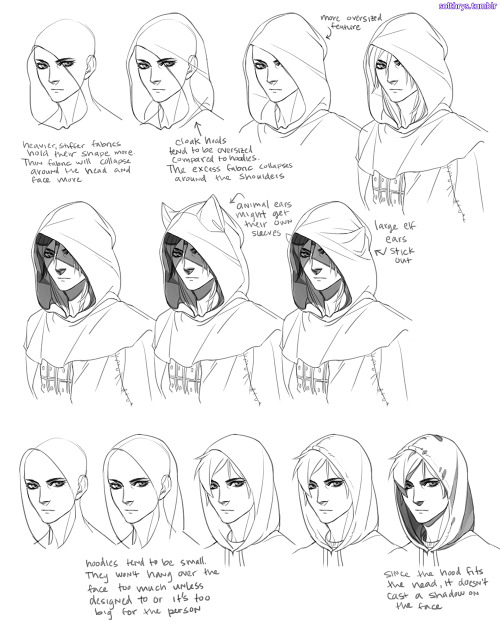

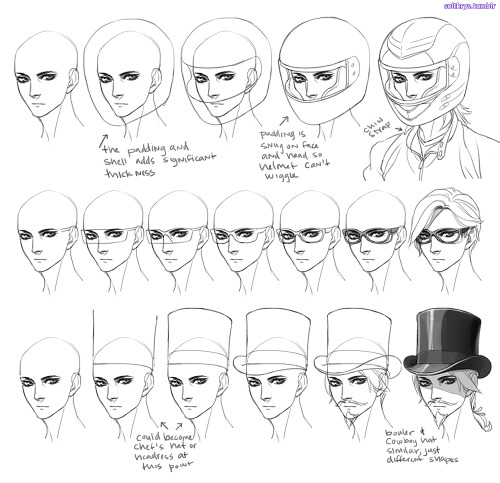
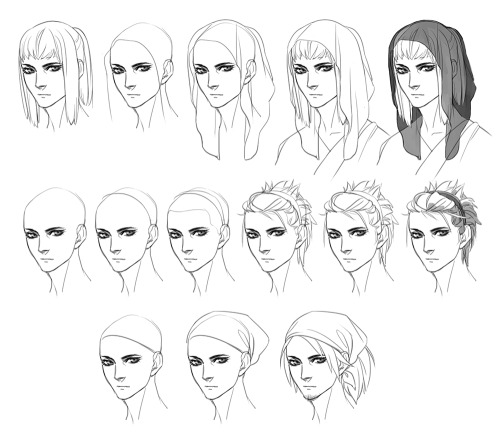
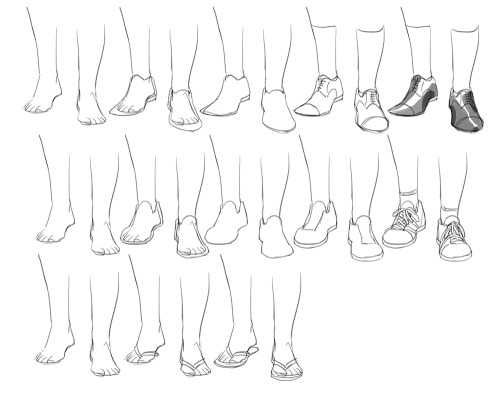
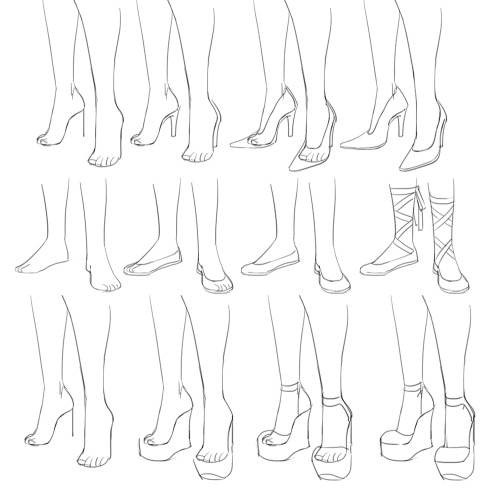
No more melted tomblerones or mising skulls, yyeann!
This is my basic process for pretty much everything I draw. The key is understanding the shape of the garment you’re trying to draw and the shape of the body part you’re putting it on.
Drawing the body first forces you to make the shoe, hat, or clothes fit that body. With practice you’ll be able to skip some steps. This method works the same no matter the perspective or pose. It just relies on your knowledge of what a hat looks like from above, or what the bottom of a shoe looks like. When in doubt, just google refs. Don’t necessarily need the exact angle you’re trying to draw. Look at different pics to give you an idea of how it works in 3d.
Shoes are always a bit tricky because feet are a stupid ass shape.
It might help if you think of hats as a cylinder fitted to the person’s head to help you get the perspective right before you push in detail. note: heads aren’t circles. they’re kind of egg shaped if you look at them from the top.

Reposted for a spelling error.
FEH Oufit meme! Have fun!
Ok to reblog and repost
Credit or link back is optional
Do not edit the meme.
-
 earthboundstray liked this · 1 week ago
earthboundstray liked this · 1 week ago -
 radval liked this · 1 week ago
radval liked this · 1 week ago -
 ternurazon liked this · 1 week ago
ternurazon liked this · 1 week ago -
 sunnytaimi liked this · 1 week ago
sunnytaimi liked this · 1 week ago -
 starcrushhologram liked this · 1 week ago
starcrushhologram liked this · 1 week ago -
 solarshadow reblogged this · 1 week ago
solarshadow reblogged this · 1 week ago -
 stardustcasti reblogged this · 1 week ago
stardustcasti reblogged this · 1 week ago -
 stardustcasti liked this · 1 week ago
stardustcasti liked this · 1 week ago -
 wolf-oc liked this · 1 week ago
wolf-oc liked this · 1 week ago -
 baldurbabe liked this · 1 week ago
baldurbabe liked this · 1 week ago -
 cxnsdellaj liked this · 1 week ago
cxnsdellaj liked this · 1 week ago -
 blogrollformysanity reblogged this · 1 week ago
blogrollformysanity reblogged this · 1 week ago -
 semestanyamin liked this · 1 week ago
semestanyamin liked this · 1 week ago -
 aleias-world liked this · 1 week ago
aleias-world liked this · 1 week ago -
 ramramrandomstuff liked this · 1 week ago
ramramrandomstuff liked this · 1 week ago -
 sunsfavorite liked this · 1 week ago
sunsfavorite liked this · 1 week ago -
 venicemermaids liked this · 1 week ago
venicemermaids liked this · 1 week ago -
 parmesanbandit liked this · 1 week ago
parmesanbandit liked this · 1 week ago -
 aut1stic-writ3r reblogged this · 1 week ago
aut1stic-writ3r reblogged this · 1 week ago -
 leiaausmus2001 liked this · 1 week ago
leiaausmus2001 liked this · 1 week ago -
 zero-sugar-null liked this · 1 week ago
zero-sugar-null liked this · 1 week ago -
 brokenheart-brokenmind6 liked this · 1 week ago
brokenheart-brokenmind6 liked this · 1 week ago -
 kkuras-gamer-gf liked this · 1 week ago
kkuras-gamer-gf liked this · 1 week ago -
 cottoncandyswirl828 liked this · 1 week ago
cottoncandyswirl828 liked this · 1 week ago -
 excelgarou liked this · 1 week ago
excelgarou liked this · 1 week ago -
 harleyyyyyyyyyyyyyyyysgsyh liked this · 1 week ago
harleyyyyyyyyyyyyyyyysgsyh liked this · 1 week ago -
 badgestxr liked this · 1 week ago
badgestxr liked this · 1 week ago -
 angryxxsigh liked this · 1 week ago
angryxxsigh liked this · 1 week ago -
 carbohydrates-dumpster liked this · 1 week ago
carbohydrates-dumpster liked this · 1 week ago -
 ghoulcifer liked this · 1 week ago
ghoulcifer liked this · 1 week ago -
 yararambles liked this · 1 week ago
yararambles liked this · 1 week ago -
 ballparkscubicle liked this · 1 week ago
ballparkscubicle liked this · 1 week ago -
 canon-brainrot liked this · 1 week ago
canon-brainrot liked this · 1 week ago -
 casualpenguin liked this · 1 week ago
casualpenguin liked this · 1 week ago -
 lavendarr00 liked this · 1 week ago
lavendarr00 liked this · 1 week ago -
 my-nameis-death liked this · 1 week ago
my-nameis-death liked this · 1 week ago -
 fortunasfavor liked this · 2 weeks ago
fortunasfavor liked this · 2 weeks ago -
 murphymakestherules liked this · 2 weeks ago
murphymakestherules liked this · 2 weeks ago -
 ampersandavenue reblogged this · 2 weeks ago
ampersandavenue reblogged this · 2 weeks ago -
 sihla9 liked this · 2 weeks ago
sihla9 liked this · 2 weeks ago -
 notatallnight liked this · 2 weeks ago
notatallnight liked this · 2 weeks ago -
 niyahjournals liked this · 2 weeks ago
niyahjournals liked this · 2 weeks ago -
 reinadelmuerte liked this · 2 weeks ago
reinadelmuerte liked this · 2 weeks ago -
 thornew liked this · 2 weeks ago
thornew liked this · 2 weeks ago -
 badsadowlet liked this · 2 weeks ago
badsadowlet liked this · 2 weeks ago -
 logosbot-tm liked this · 2 weeks ago
logosbot-tm liked this · 2 weeks ago -
 bellybuttonbooks liked this · 2 weeks ago
bellybuttonbooks liked this · 2 weeks ago -
 astudyintheburningofhearts liked this · 2 weeks ago
astudyintheburningofhearts liked this · 2 weeks ago -
 marquis-de-lafayette57 liked this · 2 weeks ago
marquis-de-lafayette57 liked this · 2 weeks ago -
 suzzettemirunette liked this · 2 weeks ago
suzzettemirunette liked this · 2 weeks ago

